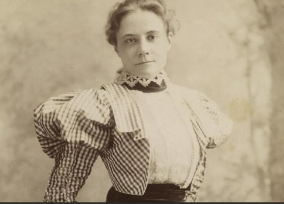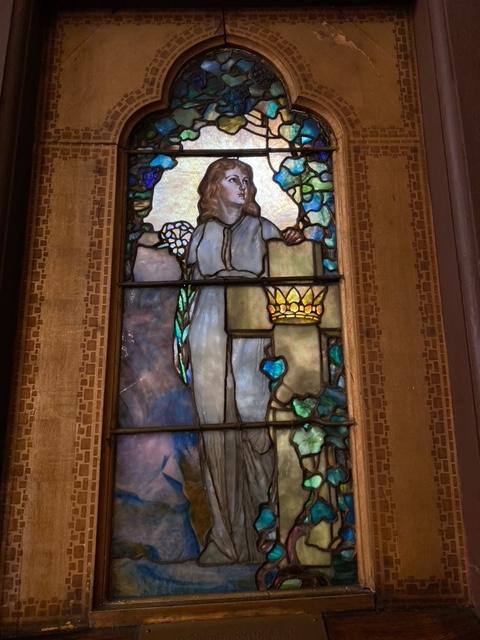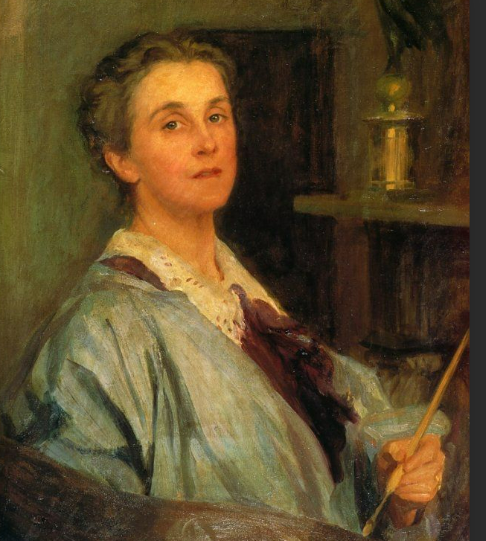Home › Forums › Participate in the Forum › March is Women History Month – KHS celebrates
- This topic has 5 replies, 6 voices, and was last updated 4 months ago by
D31rdreLa.
-
AuthorPosts
-
-
March 18, 2024 at 4:25 pm #3972
March is Women’s History Month.
The Kingsbridge Historical Society would like to highlight two women who help brighten and bring color to our interior. Our New York City Landmark building has four Tiffany Studio windows. Two of the four were designed by Women. Tiffany Studio was different than most manufacturing companies at that time to have a whole department who were women designers. Comprised of thirty-five female artists, designers, and artisans, at the height of its scale and productivity, the Women’s Glass Cutting Department at Tiffany Studios was also led by a woman as well.
The “Tiffany Girls” as they are known were such a group.

The Tiffany “Girls”
There are two large and two smaller Tiffany stain glass windows. The two smaller windows were women designed.

Landscape
“Landscape”, is one of the windows designed by Agnes Northtrop. Northrop was the foremost female artist at the Tiffany Studios.

Agnes Northrop
During her five decades at the Studios, designed nearly all of the firm’s floral, garden, and landscape windows. Northrop’s position at the Tiffany Studios was one of unusual privilege – like her male counterparts, she had a private studio and received international recognition for her work. The landscape window depicts a sunrise or sunset over a peaceful river flowing towards distant mountains. This imagery alludes to the arc of human life and is often considered a metaphor for passing into the afterlife. The window sadly memorializes two children.
This window is a classic example of landscape window designed by Agnes Northrop. For more on Agnes Northrop’s life and career, see Alice Cooney Frelinghuysen, “Agnes Northrop: Tiffany Studios’ Designer of Floral and Landscape Windows,” Louis C. Tiffany and the Art of Devotion, (New York: Museum of Biblical Art, in conjunction with D. Giles Ltd, 2012), p. 162-183. The window was unveiled on November 5, 1916 and is mentioned in two separate period publications. The Metropolitan Museum just acquired a 1912 monumental 3 panel stain glass widow created by Agnes Northrop that will be first on display starting November 2024 for the centennial of the American Wing.
Our second Tiffany window designed by a woman is “From Cross to Crown”, 1893.

The window design is attributed to Lydia Field Emmet (1866-1952). Tiffany Glass and Decorating Company is substantiated as the maker because the window is listed in A Partial List of Windows, Designed and Executed by Tiffany Studios.

Lydia Field Emmet
Tiffany Glass and Decorating Company was one of several firms founded by American artist Louis C. Tiffany (1848-1933). The successor to the Tiffany Glass Company (1885- 1892), the firm’s new name clearly announces the rapidly expanding activities and growing reputation of Tiffany’s artistic enterprise. The artist responsible for designing this window is unknown, but visual analysis suggests that American artist Lydia Field Emmet (1866-1952) may have had a hand in its design.
The face of the young woman depicted in From Cross to Crown is nearly identical to that of the young woman depicted in a Tiffany window designed by Emmet, entitled Spring and Autumn, which also dates to about 1893
Lydia Field Emmet was a renowned artist who is best known as a portrait painter. However, early in her career, she worked as an illustrator and also designed windows for Tiffany. Her name was often mentioned as one of several noteworthy American artists—male and female— who produced designs for Tiffany on a freelance basis.
The Edgehill Church’s window depicts a young woman standing next to a large cross that is two thirds her height. She holds a stalk of white lilies in one hand, representing rebirth, and her other hand rests on the top of the cross. A golden, jeweled crown decorates the intersecting point of the cross.
For a short biography of Lydia Field Emmet, see Catherine Southwick, Robert Torchia, “Lydia Field Emmet,” NGA Online Editions. This window is extremely significant. The window design is unique; no other examples are known. This one-of-a-kind window design is typical during the early years of Tiffany’s window production when his firms worked with an array of different artists, many who had well-established careers and were famous in their own right.
Cross to Crown Window 1893 Tiffany Glass and Decorating Company (1892-1900); design attributed to Lydia Field Emmet (1866-1952). Dedicated ‘IN REMEMBRANCE OF ISAAC G. JOHNSON JR. 1882- 1893’ (bronze plate).
These short excerpts were taken from the Tiffany Window study and analysis the Kingsbridge Historical Society had performed last year, Thanks to a grant from the New York Landmarks Conservancy. The study and research was performed by Liberty Stain Glass Conservation lead by Brianne Van Vorst. If you saw either the NYTimes article dated March 3, 2024 titled “What’s Hidden in Woodlawn’s Hidden Mausoleum’s? Extraordinary Stain Glass” or the article of March 17, 2024 titled “A Resting Place, an a Stained-Glass Trove” Brianne is highlighted as one of the main researchers on the project to document all the stain glass windows in Woodland’s mausoleums.
So, the next time you’re at a KHS meeting at Edgehill please give a look at these two Tiffany windows as well as the other 2 windows. All of them are local treasures.
-
March 19, 2024 at 8:22 am #3973
Fascinating to learn about the women behind the scenes that made those gorgeous windows. Thanks for sharing and great photos.
-
March 19, 2024 at 1:20 pm #3974
This is wonderful! Is there a link for the full report on the stained-glass windows? Thanks for sharing.
-
March 19, 2024 at 2:19 pm #3975
Peter, many thanks for the details…. It is almost ready for a booklet to sell
-
March 19, 2024 at 3:18 pm #3976
Great to learn of Agnes Northrop and Lydia Field Emmet ! Both are remarkable! Thank you Peter.
-
March 25, 2024 at 1:56 pm #3986
Agnes Northrop and Lydia Field Emmet were not the only famous women designer/artists at Tiffany Studios (which, by the way was not the successor to Charles L. Tiffany’s (1812-1902) company, “fancy goods,” or jewelry store. Tiffany’s remains a NYC icon and is now owned by LVMH, an international conglomerate.
Clara Wolcott Driscoll (1861-1944) was also a famous artist/designer who headed Tiffany Studio’s Women’s Glass Cutting Department aka “The Tiffany Girls,” a job Northrup gladly handed over to her. Driscoll designed beautifully wrought lamps of many colors, primarily with botanic themes, over three tenures at Tiffany Studios from 1888 until 1909 when she was prevented by contemporary gender norms and pervasive sexism to retire.
Clara Wolcott graduated from Midwestern Reserve School of Design for Women and in 1888 moved to Brooklyn and then to NYC to further her studies and career in art. In 1889, she went to work at Tiffany Studios, where Louis Comfort Tiffany believed that women and young girls (some as young as fifteen) had a better sense of color and design than men in assembling his beautiful lampshades. (The women were paid on the same scale as the men.) She had to leave TS twice temporarily and once permanently. The first time was in 1889 when she became engaged to marry Francis Driscoll. Following his death in February 1892, she returned to TS. Clara Driscoll had to leave once again when she became engaged to Edwin Waldo, but she returned to TS when Waldo disappeared. (Years later he resurfaced, claiming amnesia.) In 1909, Clara Driscoll wed Edward Booth and had to leave work for the last time. In retirement, she painted scarves.
A cache of letters, about 350 or so, has been discovered in the Queens Historical Society and at Kent State University in Ohio. Clara and her mother and younger sisters corresponded often about what was happening in their lives.
In 2007 an exhibition at the New-York Historical Society, which now has a permanent two-story gallery of TS lampshades, their design process, and other objects made by TS. The N-YHS owns 132 lampshades, 100 of which are on display, 63 of which are attributed to Clara Driscoll. This is the Neustadt collection. (In the corridor outside this gallery there is also a large display of objects made made and sold by Tiffany’s, the iconic jewelry store. Downstairs, on the first floor of the N-YHS, there is a restaurant named Clara.)
In 1892, Tiffany Studios Women’s Glass Cutting Department took advantage of an opportunity when the exclusively male union went out on a city-wide strike. The women and girls of the WGCD did every step of the process in making the lampshades except the final soldering, which could only be done by men in Corona, Queens. In 1903, the men’s union, the Lead Glaziers and Glass Cutters’ Union, demanded that only men be allowed to make stained glass windows. This effectively ended Northrup’s and other women’s careers in this area.
Clara Driscoll was famous in her time, but like many other women, was soon forgotten. (See the article on her, which appeared in the NYTimes “overlooked series of obituaries” that “went unreported” at the time) February 2023. Driscoll won many prizes like the bronze medal at the 1900 Paris World’s Fair. The only name that appears on the lampshades is that of Louis Comfort Tiffany. The Tiffany lampshades were made and were popular during the Gilded Age, when electrification was replacing oil-fueled lighting on city streets and in homes. Louis Comfort Tiffany had been trained as a landscape painter, but soon turned to interior design preferring to find ways to introduce nature and art into American homes. His innovative opalescent glass, which incorporated color and texture became popular for use in stained glass windows for churches, sanatoriums, and mausoleums. The Tiffany girls turned leftover glass into lampshades, many of which Clara Driscoll designed and Tiffany marketed as the Wisteria, the Cobweb, the Arrowhead, the Butterfly, the Dragonfly, etc for use as table lamps, floor lamps, and chandeliers in middle-class and upper-class homes.
Visit the New-York Historical Society on Central Park West at 77th Street to learn much more about the art of stained glass, Clara Driscoll, and the “Tiffany Girls.”
-
-
AuthorPosts
- You must be logged in to reply to this topic.